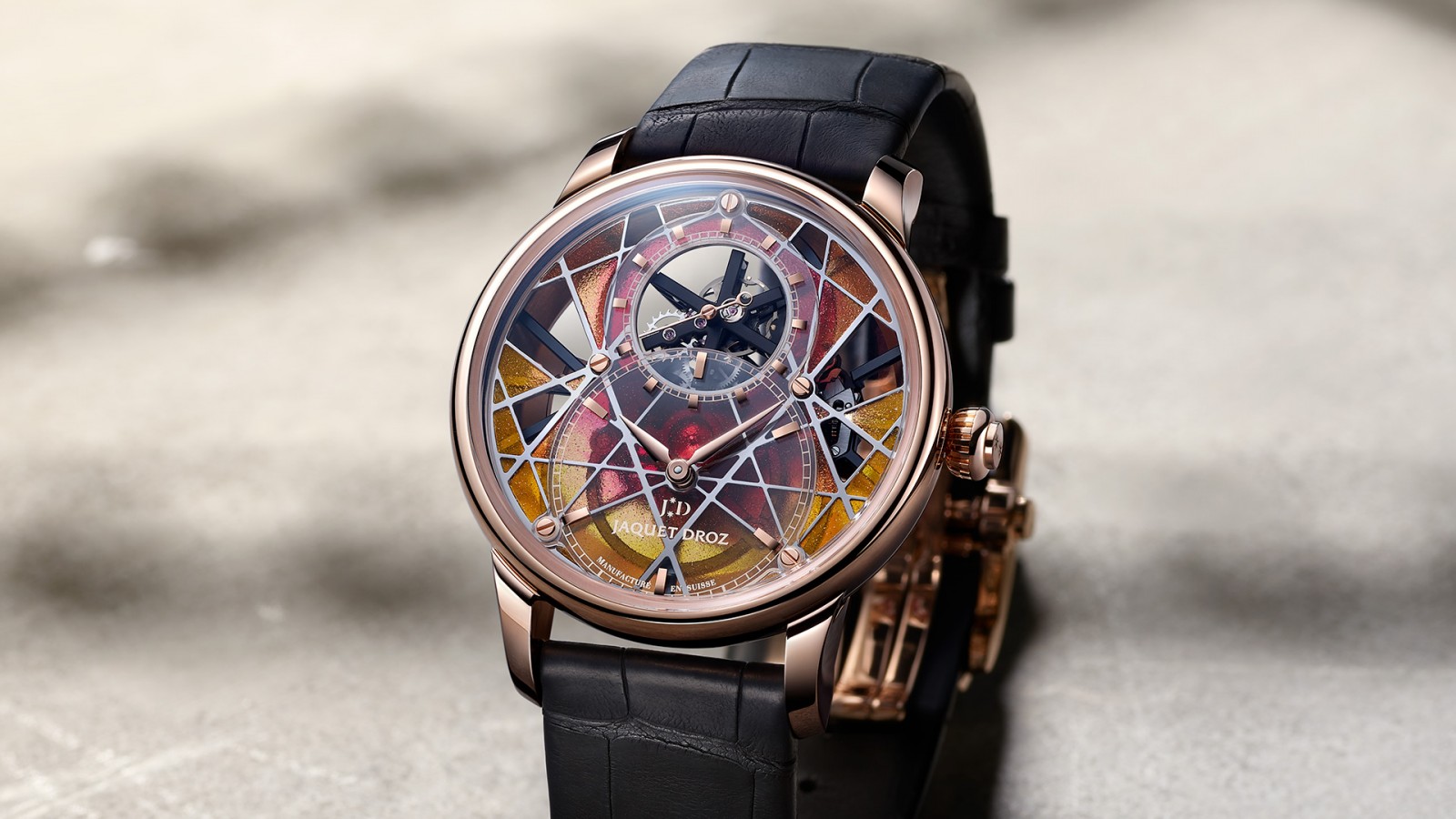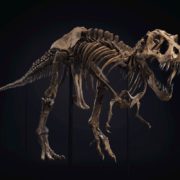‘This is one of the best specimens discovered,’ says James Hyslop, head of Christie’s Science & Natural History department. Unearthed in 1987, less than a century after the existence of Tyrannosaurus rex had first become known, STAN — named after his discoverer Stan Sacrison — represents one of the most complete fossil skeletons of the most famous dinosaur species ever to have lived.
6–8 October 2020
Found in 1987 and one of the most complete fossils of its kind, Stan is going up for sale Oct. 6. $6,000,000+.
Human beings have only been aware of T. rex since the dawn of the 20th century, after remains were first documented by the legendary palaeontologist, Barnum Brown.
In 1900 and 1902, ‘Mr Bones’, as the then assistant curator of the American Museum of Natural History was known, found partial skeletons in Wyoming and on the Montana side of the Hell Creek Formation. (The same landscape of Upper Cretaceous rocks where STAN was found across the border in South Dakota.)

T. rex, soon after dubbed ‘the prizefighter of antiquity’, has been a subject of global fascination ever since — a fusion of science, history and popular culture in the public imagination.
Quickly adopted by cinema, the most fearsome of dinosaurs appeared in The Lost World (1925), fought the climactic battle with King Kong (1933) and shared a striking resemblance to Godzilla (1954). Its most spectacular screen role came in 1993 with Jurassic Park, in which it became a monster for the ages.
A male Tyrannosaurs rex. From the Hell Creek Formation, 16 meters below the K-T boundary, Maastrichtian, Late Cretaceous (circa 67 million years ago). Approx. 190 bones surviving and mounted on custom frame with additional cast elements. A separate display for the original skull and teeth. Size: 37 x 13 x 6 ft (1128 x 396 x 183 cm). Estimate: $6,000,000-8,000,000. Offered in the 20th Century Evening Sale on 6 October at Christie’s in New York
STAN will be offered on 6 October in the 20th Century Evening Sale at Christie’s in New York — ‘a once in a generation chance’, according to Hyslop. ‘There simply aren’t T. rexes like this coming to market. It’s an incredibly rare event when a great one is found.
‘It is such an iconic piece of the 20th century, and fits so well in the context we are offering it.’ Archetype, movie star, pop-culture celebrity, it is fitting that STAN will make his auction debut alongside masterpieces of modern and contemporary art.
‘T. rex is a brand name in a way that no other dinosaur is,’ says Hyslop.‘It sits very naturally against a Picasso, a Jeff Koons or an Andy Warhol.’

Born in the Badlands
STAN lived in the late Cretaceous period — the prehistoric age that ended mysteriously and abruptly some 65 million years ago with the mass extinction of the dinosaurs.
He was born, grew up and died in a humid, semi-tropical region of an island continent identified as Laramidia, an area known today as the Badlands, which spans North and South Dakota, Wyoming and Montana in the United States of America.
The vulnerable, feathered youngster
Hatched from an elongated egg much like a modern bird, STAN was defenceless as an infant and, according to recent scientific research, covered in feathers. Many of his fellow hatchlings would have perished by the age of one, victims to scavengers or cannibalised by another T. rex.
Although he would grow up to become an apex predator, STAN remained vulnerable as a juvenile. No larger than a small turkey, he required the constant protection of his parents. Between the ages of six and 18, however, he underwent an astonishing growth spurt of an estimated six pounds per day.
Almost 40 feet long, nose to tail, with incredible eyesight
At his largest, STAN would have boasted a body mass of between seven and eight tons — twice as heavy as the average modern African elephant. He measured a towering 13 feet high, and almost 40 feet long with his heavy tail fully outstretched.
His aquiline snout once housed an intricate system of blood vessels, functioning as a giant biological air conditioner. With eyes the size of baseballs, STAN would have been able to pinpoint another dinosaur from six kilometres away — a range far superior to any bird of prey today.
Added to these attributes, STAN possessed an impressive sense of smell, as revealed by the internal structure of his enormous skull. Although a preserved T. rex brain has yet to be found, the impression left behind reveals that the largest part of the brain was dedicated to the ‘olfactory bulbs’.
Agility, cunning and brute strength — STAN’s bite could easily have crushed a car
The large space set aside for these ‘bulbs’ confirms STAN was a carnivore. They would also have equipped him for hunting at night and over long distances. Through this potent combination of agility, cunning, and brute strength, STAN would have thrived as a predator with no competitors or threats other than his fellow T. rexes.
While his short, two-fingered forearms were less than impressive — prone to disease and, unfortunately given his prodigious appetite, too short to reach his mouth — they most probably came in useful for seizing prey or carcasses.

This is just as well, for it is thought STAN could eat up to 500lbs of meat in one bite. He had as many as 58 teeth, the longest of which measures 11½ inches. Each tooth has serrated edges which could crush and slice straight through the flesh and bone of its prey.
In 2005, STAN’s skull was reproduced and tested to recreate a bite force of four tons per square inch — easily enough to crush a car. A 2012 study concluded that STAN’s front teeth had probably evolved to grip and pull, while his side teeth tore flesh and his back teeth sliced chunks of meat, forcing them down into the throat.
In the swamps and forests where he lived, STAN survived attacks from his own species
Further study of STAN’s impressive skull reveals that his life was not exactly carefree. Vicious puncture wounds neatly fitting a T. rex tooth strongly suggest he was himself a wounded warrior who suffered attacks by his own species. Though unaccustomed to running from anything, his powerful thigh muscles enabled STAN to move at a speed of between 10 and 25 mph.
STAN and his kind lived in coastal swamps and forested valleys close to rivers, which attracted a variety of prey. Although debate has raged as to whether the T. rex was a hunter or a scavenger, STAN was fully equipped for pursuit independently or in a group of Tyrannosaurs (aptly known as a ‘terror’).
His killer instinct was confirmed during the excavation of his skeleton in 1992, when he was found with the fossilised and partially digested remains of an Edmontosaurus, a large duck-billed dinosaur, and a Triceratops, a hulking three-horned dinosaur which, despite being a herbivore and potential prey to the T. rex, would have been a formidable opponent. These bones each had bite marks, revealing how STAN could hunt, kill, and devour even the largest and most well-protected herbivores.
Amateur palaeontologist Stan Sacrison’s incredible discovery
After STAN died and decomposed, his skeleton was gradually blanketed and compacted by sediment, sand and mud. The incredible survival of his skeleton is the result of fossilisation, a transformational process which took place over millions of years.
Over time, STAN’s organic bones were mineralised by water seeping through the sediment, which then hardened into the stone relics discovered in the spring of 1987, when amateur palaeontologist Stan Sacrison went searching for traces of dinosaurs within the Hell Creek Formation, and uncovered a dinosaur’s fossilised hip bone, which was later confirmed to have been STAN’s.

The most widely exhibited dinosaur of all time
Each individual fossil from STAN’s skeleton had to be prised carefully from the rock, then stored and recorded. Following more than 30,000 hours of labour, STAN was erected on a custom mount to reflect his former glory. He was given a public unveiling on Hill City’s Main Street in South Dakota, followed by his global ‘debut’ as the centrepiece of Japan’s T. rex World Exposition in 1995.
More than 30 years after his discovery, STAN is recognised and revered as a scientific and cultural sensation. As one of the two most complete T. rex skeletons ever found — and the most reproduced as casts in history — he is almost certainly the most viewed and widely exhibited dinosaur of all time.
STAN is now on view at Christie’s in New York. Email TREX@christies.com to request an appointment.
Fuente y fotografias: Christie’s





























































